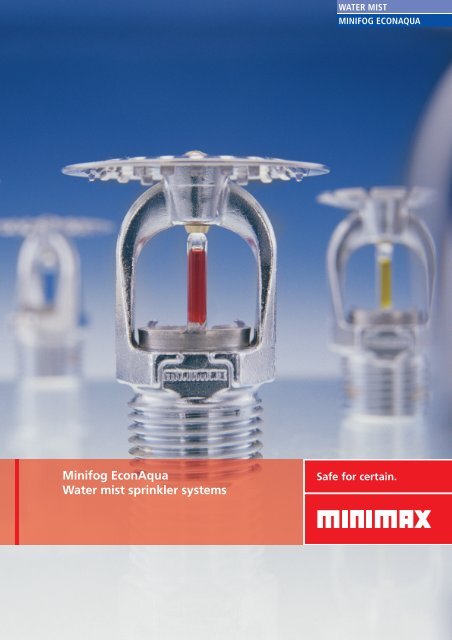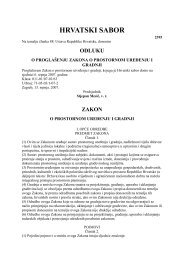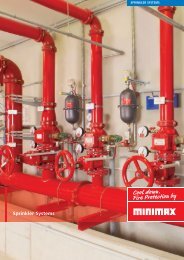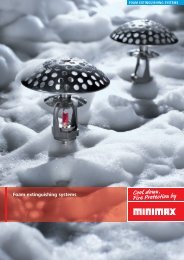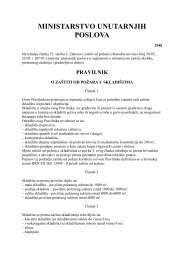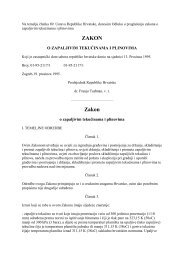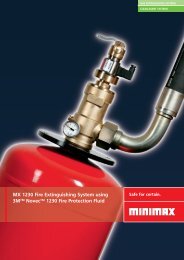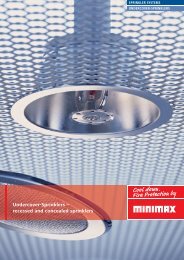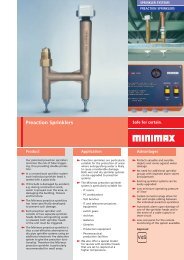Minifog EconAqua water mist sprinkler systems
Minifog EconAqua water mist sprinkler systems
Minifog EconAqua water mist sprinkler systems
Create successful ePaper yourself
Turn your PDF publications into a flip-book with our unique Google optimized e-Paper software.
WATER MIST<br />
MINIFOG ECONAQUA<br />
<strong>Minifog</strong> <strong>EconAqua</strong><br />
Water <strong>mist</strong> <strong>sprinkler</strong> <strong>systems</strong><br />
Safe for certain.
NNOVATION<br />
Efficient building protection<br />
<strong>Minifog</strong> <strong>EconAqua</strong> <strong>water</strong> <strong>mist</strong> <strong>sprinkler</strong> <strong>systems</strong><br />
developed by Minimax use innovative lowpressure<br />
<strong>water</strong> <strong>mist</strong> technology to offer a<br />
particularly efficient system of fire fighting in<br />
office and administration buildings, in underground<br />
car parks and in buildings with comparable<br />
fire hazards. Persons, physical assets and<br />
the envir onment are thus safely protected<br />
round the clock. Their use can meet official<br />
requirements – for instance those involved<br />
when applying for a building permit. Fire<br />
insurers also have recognised the effective fire<br />
protection provided by <strong>Minifog</strong> <strong>EconAqua</strong> by<br />
granting premium discounts.<br />
<strong>Minifog</strong> <strong>EconAqua</strong> uses up to 85% less <strong>water</strong><br />
than classic <strong>sprinkler</strong> <strong>systems</strong>. This level of<br />
efficiency can otherwise only be achieved using<br />
expensive, high-pressure extinguishing <strong>systems</strong><br />
that typically work with operating pressures in<br />
the range of 40 to 120 bar. With <strong>Minifog</strong><br />
<strong>EconAqua</strong>, the screening method extensively<br />
used during the development of the <strong>EconAqua</strong><br />
<strong>water</strong> <strong>mist</strong> <strong>sprinkler</strong> means that a maximum<br />
operating pressure of 16 bar is quite sufficient.<br />
Due to the extremely low amount of <strong>water</strong><br />
used, potential <strong>water</strong> damage is reduced to<br />
a minimum. Moreover, the <strong>EconAqua</strong> pump<br />
room can generally be to a much more compact<br />
design than a classic <strong>sprinkler</strong> pump house.<br />
This saves space and so saves construction costs<br />
as well. In addition, the use of pipes with much<br />
smaller diameters leads to substantial space<br />
savings along the pipe routes, particularly in<br />
ceiling areas. Many buildings which could not<br />
be fitted with extinguishing <strong>systems</strong> due to a<br />
lack of space can now be retrofitted with a fire<br />
extinguishing system, thanks to <strong>Minifog</strong><br />
<strong>EconAqua</strong>.<br />
<strong>Minifog</strong> <strong>EconAqua</strong> <strong>water</strong> <strong>mist</strong> <strong>sprinkler</strong> <strong>systems</strong><br />
can also be used without hesitation for the<br />
protection of multi-storey car parks and underground<br />
garages exposed to frost – the reason<br />
is that as with classic <strong>sprinkler</strong> <strong>systems</strong>, dry<br />
areas can be created which are filled with<br />
compressed air instead of <strong>water</strong> when the<br />
system is in an operational state so as to avoid<br />
any frost damage.<br />
The outstanding suitability of <strong>Minifog</strong> Econ<br />
Aqua has been documented through extensive<br />
fire and extinguishing tests carried out under<br />
real conditions in mock-ups of original buildings.<br />
The <strong>EconAqua</strong> System is approved and<br />
certified by the German VdS.<br />
Classic <strong>sprinkler</strong><br />
<strong>EconAqua</strong> <strong>sprinkler</strong>
DESIGN AND F<br />
Safety at its best<br />
In its design and function <strong>Minifog</strong> <strong>EconAqua</strong> is<br />
similar to a classic <strong>sprinkler</strong> system. The system is<br />
subdivided into one or more extinguishing<br />
zones, the corresponding selector valve sets<br />
and the <strong>EconAqua</strong> pump room.<br />
Extinguishing zones<br />
A pipework with <strong>EconAqua</strong> <strong>water</strong> <strong>mist</strong> <strong>sprinkler</strong>s<br />
runs through the areas to be protected.<br />
The nominal pipe diameters used in these<br />
areas mainly lie between DN20 and DN40 and<br />
are much smaller than those used in classic<br />
<strong>sprinkler</strong> pipework. In operational conditions<br />
the pipework in the extinguishing zones is<br />
filled with pressurised <strong>water</strong> (wet areas) or<br />
with compressed air (dry areas). Additional<br />
feed is provided by means of a jockey pump<br />
or by a compressor. In the event of a fire, only<br />
the <strong>water</strong> <strong>mist</strong> <strong>sprinkler</strong>s located in the immediate<br />
vicinity of the fire source open up. These<br />
allow the fire to be fought immediately and<br />
using a low volume of finely sprayed <strong>water</strong>.<br />
The remaining <strong>sprinkler</strong>s remain closed.<br />
<strong>EconAqua</strong> selector valve sets<br />
The extinguishing system is subdivided by means<br />
of <strong>EconAqua</strong> selector valve sets into individual<br />
wet and dry areas. When the system is ready<br />
for operation, the units that maintain the<br />
pressure in the pipework of the extinguishing<br />
zones are controlled via these sets. In the event<br />
of a fire, i.e. after a <strong>sprinkler</strong> has opened up,<br />
the pressure in the pipework of the exting<br />
uishing zone affected drops to a level such<br />
that the associated valve set opens up. This<br />
initiates the extinguishing process. At the same<br />
time an alarm is set off and the location of the<br />
fire is indicated.<br />
Extinguishing zones<br />
Wet pipe system for frost-protected rooms<br />
Water <strong>mist</strong> extinguishing <strong>systems</strong><br />
Since 1993, Minimax has developed and installed<br />
high-pressure and low-pressure <strong>water</strong> <strong>mist</strong> extin -<br />
g uishing <strong>systems</strong> under the “<strong>Minifog</strong>” brand name<br />
for a wide range of applications, thus making it one<br />
of the pioneers of <strong>water</strong> <strong>mist</strong> technology. The fine<br />
spray technology – often also called fine <strong>water</strong> spray<br />
technology – utilizes the physical properties of the<br />
<strong>water</strong> more efficiently than classic <strong>water</strong> extinguishing<br />
<strong>systems</strong>. The <strong>water</strong> is emitted through special<br />
nozzles and <strong>sprinkler</strong>s as a very fine spray under<br />
increased operating pressures. The result is a larger<br />
total surface of the extinguishing <strong>water</strong>, allowing it<br />
to absorb heat and to evaporate more quickly. The<br />
cooling and smothering effect allows for particularly<br />
effective fire fighting using a minimum amount of<br />
extinguishing <strong>water</strong>.<br />
<strong>EconAqua</strong> pump room <strong>EconAqua</strong> selector<br />
valve sets<br />
Town main<br />
Strainer with<br />
fine sieve<br />
Automatic feed<br />
mechanism<br />
Storage tank<br />
Eco<br />
sel<br />
set<br />
Alternative: direct connection<br />
to the public drinking<br />
<strong>water</strong> system<br />
Town main<br />
Strainer with<br />
fine sieve<br />
Double<br />
preven
UNCTION<br />
WATER MIST<br />
MINIFOG ECONAQUA<br />
<strong>EconAqua</strong> pump room<br />
In addition to the units which maintain the<br />
pressure in the pipework of the extinguishing<br />
zones the <strong>EconAqua</strong> pump room also includes<br />
the fire detection control panel, the central<br />
alarm station, the main pump, a <strong>water</strong> source,<br />
and various other components that ensure<br />
operation of the extinguishing system. The much<br />
smaller amount of extinguishing <strong>water</strong> used<br />
means that the space required for the <strong>EconAqua</strong><br />
pump rooms is up to 80 % less than that for<br />
corresponding classic <strong>sprinkler</strong> pump houses. The<br />
signals of the selector valve set are transmitted<br />
to the fire detection control panel, from where<br />
alarms are set off to alert rescue teams. The<br />
central alarm valve ensures both visual and<br />
audible alarms in the <strong>EconAqua</strong> pump room.<br />
The pump starts up if the pressure in the main<br />
distribution piping drops as a result of one of<br />
the selector valve sets opening up. Alternative<br />
sources of <strong>water</strong> for feeding the main pump or<br />
the jockey pump are available, either a <strong>water</strong><br />
tank with automatic additional feed or a direct<br />
connection to the public drinking <strong>water</strong><br />
system, e.g. via the BAMX double backflow<br />
preventer.<br />
Dry pipe system for rooms subject to frost hazard<br />
<strong>EconAqua</strong><br />
selector valve set dry<br />
nAqua<br />
ector valve<br />
wet<br />
Test line for pump<br />
Optical and<br />
acoustic alarm<br />
Central<br />
alarm<br />
station<br />
Minimax<br />
fire detection and control panel<br />
Acoustic<br />
alarm<br />
Fire brigade<br />
<strong>EconAqua</strong><br />
master<br />
pump<br />
Control cabinet<br />
Compressor<br />
unit<br />
<strong>EconAqua</strong><br />
jockey pump<br />
<strong>EconAqua</strong> master pump<br />
backflow<br />
ter
APPLICATION<br />
A class of its own<br />
The range of applications for which the <strong>Minifog</strong><br />
<strong>EconAqua</strong> <strong>water</strong> <strong>mist</strong> <strong>sprinkler</strong> system can be<br />
used is divided into fire hazard classes as defined<br />
in the VdS guidelines for <strong>sprinkler</strong> <strong>systems</strong><br />
(VdS CEA 4001). These include fire hazard<br />
classes LH, OH1 (which do not involve risks to<br />
production) and OH2 (only multi-storey car<br />
parks and underground garages).<br />
Typical applications<br />
<br />
<br />
<br />
<br />
<br />
<br />
<br />
<br />
<br />
<br />
<br />
<br />
<br />
<br />
Banks<br />
Churches<br />
Hospitals, old people’s homes<br />
and other care facilities<br />
Hostels and apartment houses<br />
Hotels<br />
Libraries<br />
Multi-storey car parks<br />
Office and administration buildings<br />
Official and government buildings<br />
Penal institutions and approved schools<br />
Railway stations<br />
Restaurants<br />
Schools, universities<br />
and other educational establishments<br />
Underground garages
OPTIMAL<br />
<strong>Minifog</strong> <strong>EconAqua</strong> – the optimal solution<br />
Wherever a <strong>Minifog</strong> <strong>EconAqua</strong> <strong>water</strong> <strong>mist</strong><br />
<strong>sprinkler</strong> system can be used, it is generally the<br />
optimal solution, since <strong>Minifog</strong> <strong>EconAqua</strong><br />
combines the advantages of a <strong>sprinkler</strong> system<br />
with those of a high-pressure extinguishing<br />
system. One important criterion to be considered<br />
in evaluating the various alternatives for a<br />
specific application is the total cost of the<br />
equipment. Besides the direct costs of installing<br />
the equipment this also includes the cost of<br />
constructing the pump room, costs for connections<br />
to the electricity and <strong>water</strong> supply networks,<br />
and the main ten ance costs.<br />
With high-pressure extinguishing <strong>systems</strong><br />
used in areas subject to frost there are usually<br />
additional costs for an associated pipeline<br />
heating system, because with these <strong>systems</strong> –<br />
other than for <strong>Minifog</strong> <strong>EconAqua</strong> or classic<br />
<strong>sprinkler</strong> <strong>systems</strong> – it is not possible to create<br />
dry areas.<br />
Example:<br />
<strong>Minifog</strong> <strong>EconAqua</strong> saves on construction costs.<br />
The use of <strong>Minifog</strong> <strong>EconAqua</strong> for a hospital in Germany<br />
can lead to a pump room which is around 15 m 2 smaller<br />
than one for a classic <strong>sprinkler</strong> system. Taking into<br />
account the average building costs for hospitals of<br />
1,780 €/m 2 (source: German BKI 2004), the reduced<br />
space requirements alone lead to construction cost<br />
savings of some 27,000 €.<br />
Typical result of an assessment of the alternatives:<br />
<strong>Minifog</strong> <strong>EconAqua</strong> is the optimal solution<br />
Criterion<br />
Technical criteria<br />
Classic <strong>sprinkler</strong><br />
system<br />
<strong>Minifog</strong> <strong>EconAqua</strong><br />
<strong>water</strong> <strong>mist</strong><br />
<strong>sprinkler</strong> system<br />
High-pressure<br />
extinguishing<br />
system<br />
Use of <strong>water</strong> – + ++<br />
Space required for the<br />
pump room<br />
– + +<br />
Space required for the<br />
pipe routes<br />
– + ++<br />
Opportunities for connecting<br />
to other <strong>water</strong> networks,<br />
opportunity for fire brigade<br />
inlet<br />
++ + o<br />
Provision to prevent<br />
<strong>sprinkler</strong> clogging<br />
Economic criteria<br />
Direct system installation<br />
costs<br />
Costs for the construction<br />
of the pump room<br />
Cost for connections to the<br />
electricity and <strong>water</strong> supply<br />
networks<br />
++ + o<br />
++ + ––<br />
– + +<br />
o + o<br />
Maintenance costs + + ––<br />
Total cost of the equipment + ++ –<br />
++ very beneficial + beneficial o neutral<br />
– disadvantageous –– very disadvantageous<br />
A Classic <strong>sprinkler</strong> pump house<br />
B <strong>Minifog</strong> <strong>EconAqua</strong> pump room<br />
including storage tank<br />
C <strong>Minifog</strong> <strong>EconAqua</strong> pump room with<br />
direct connection to the puplic drinking<br />
<strong>water</strong> system<br />
Minimax GmbH & Co. KG<br />
Industriestrasse 10/12<br />
23840 Bad Oldesloe<br />
Germany<br />
Phone: +49(0)4531/803-0<br />
Fax: +49(0)4531/803-248<br />
E-mail: info@minimax.de<br />
www.minimax.de<br />
No. S 89201<br />
Certified according to<br />
ISO 9001<br />
PB05We_02/08.05/3/05.06/HA


